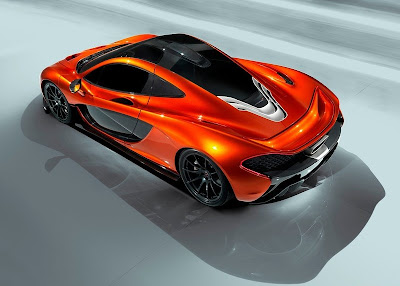McLaren P1 Concept (2012). Hello all, this time Worldofcarsfans share information about the 2012 McLaren P1 Concept Release. McLaren Automotive used its first ever international motor show appearance to preview its next generation ultimate supercar - the McLaren P1 - which takes much of its technological and spiritual inspiration from the company's Racing division.

The McLaren P1 has one simple goal: to be the best driver's car in the world on road and track.
2012 McLaren P1 Concept
The new McLaren P1 has much higher levels of downforce than any current road car - 600kg is achieved well below maximum speed. That is approximately five times as much downforce as a McLaren 12C. Its margin over most other high performance supercars is even greater. The McLaren P1's downforce is similar to current sports racing cars, including the 12C GT3 racer.
The McLaren P1 showcases McLaren Automotive's advanced motorsport-based engineering, prioritising high performance through state-of-the-art technology. It will feature notable advances in weight reduction, packaging, high-speed performance, materials (especially carbon fibre), powertrain and in aerodynamics.
Aerodynamic led design
The McLaren P1 prioritises function over pure style, notes Chief Design Engineer Dan Parry-Williams. That is very much part of the McLaren ethos. 'It is engineering design led. Yet it is a striking and handsome car. The P1 reflects McLaren's core values. It celebrates aerodynamics, great packaging and light weight. It is all about innovative technology. At the very beginning, we sought to develop a car that you could drive to a racing circuit, then press a button and race it. Maximum speed was never a priority. It's much more technically challenging, and more meaningful, to develop a car that seeks to be the fastest-ever series production car on a racing circuit. That also makes it much more road relevant than just sheer top speed.

Active aerodynamics include Formula 1-like DRS
The former Head of Aerodynamics for the McLaren Racing, and now Head of Vehicle Technology for McLaren Automotive, Simon Lacey, was responsible for the aero performance: 'The astonishing downforce actually makes driving easier as well as faster,' says Lacey. 'As you go faster, you actually feel more in control.'
The large rear wing adjusts automatically to boost downforce and optimise aerodynamics. It can extend rearwards by up to 300mm on a racetrack, and by up to 120mm on the road. The pitch of the rear wing can increase by up to 29 degrees. The double element rear wing profile has been developed using exactly the same methods and software as the current McLaren Formula 1 car.
The McLaren P1 also has a DRS (drag reduction system) function, like a Grand Prix car, to reduce downforce and increase straight line speed. But while a Formula 1 car has a moveable flap in the rear wing, the McLaren P1's rear wing's pitch is adjusted.
In addition to the adjustable 'active' rear wing, the McLaren P1's aerodynamic performance is optimised using two flaps mounted under the body ahead of the front wheels. These are also actively controlled, and change angle automatically to optimise performance, boosting downforce and aero efficiency, increasing both speed and driver confidence. The flaps operate through a range of 0-60 degrees.
Lightweight carbon 'multi-purpose' body panels
As with the legendary McLaren F1 road car of 1992, the McLaren P1 is a mid-engine design that uses a carbon fibre monocoque and roof structure safety cage concept called MonoCage which is a development of the MonoCell used in the current 12C and 12C Spider. The structure of the MonoCage, unlike the 12C's MonoCell, also serves to guide air into the engine through an integral roof snorkel and air intake ducts, saving further weight. All the body panels are carbon fibre to reduce weight. This carries on a McLaren innovation: it was the first company to offer a full carbon body Grand Prix car (in 1981) and the first to offer a full carbon body road car (the F1).
'Genuinely beautiful and at the forefront of automotive design'
Working closely with Parry-Williams, Design Director Frank Stephenson wanted a car that was 'striking but also functional, a real statement of intent. I wanted a genuinely beautiful and dramatically honest "supersports" car, in keeping with McLaren's heritage but also at the forefront of automotive design'.
The lights are a signature part of the car. The LED headlights, with their speed marque DRL, are extremely small in size meaning more frontal area can be devoted to cooling. Whilst at the back, the low rear deck and pronounced wheelarches, give the evocatively simple rear end a powerful graphic. The concept being that the rear lamps are literally the trailing edge of the bodywork, framing the diffuser and allowing more heat to exit from the engine bay. 'Again, beautiful, organic forms framing and enhancing the technical features,' says Stephenson
McLaren's 'ultimate car' heritage
The McLaren P1 follows in the footsteps of the classic McLaren F1 as the 'ultimate car' offering. The name ties in with Grand Prix racing. P1 means first place - and McLaren has 180 GP victories in its 46 year Formula One history - or position one on the grid (McLaren has scored 153 pole positions). There is also heritage in that name: the McLaren F1 was initially known as Project 1, or P1
The McLaren F1 was lauded as the greatest supercar of its era when it was first shown 20 years ago. At the time, it was the world's most technologically advanced and fastest supercar. 2012 McLaren P1 Concept Release Such information and may be useful for us all..
Judul : 2012 McLaren P1 Concept Release
Deskripsi : McLaren P1 Concept (2012) . Hello all, this time Worldofcarsfans share information about the 2012 McLaren P1 Concept Release . McLaren Auto...